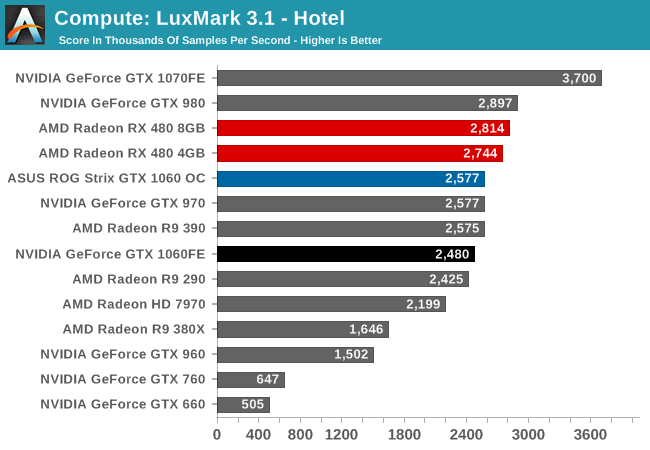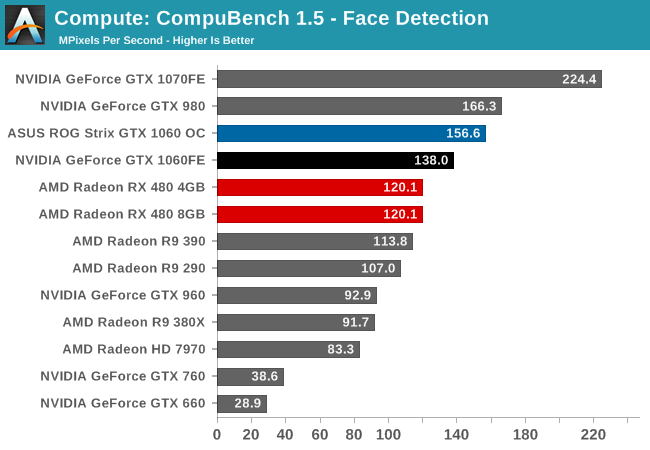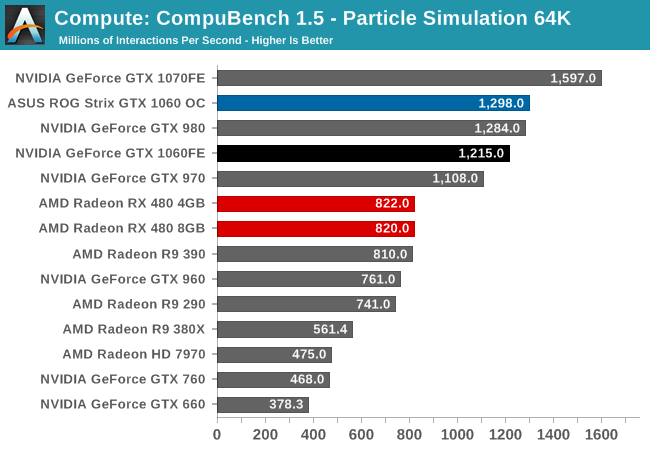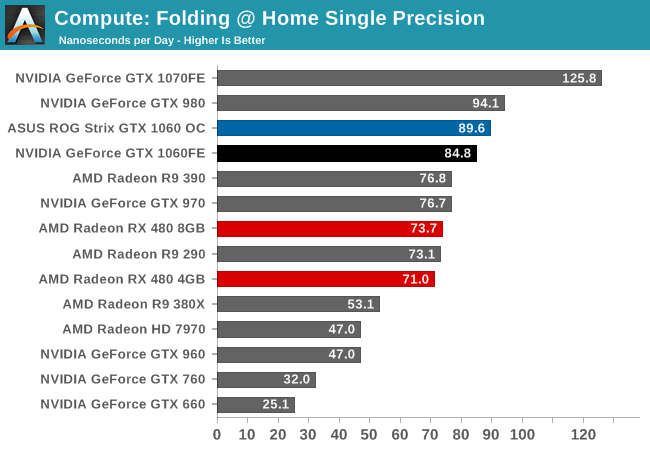The GeForce GTX 1060 Founders Edition & ASUS Strix GTX 1060 Review
by Ryan Smith on August 5, 2016 2:00 PM ESTCompute
Shifting gears, let’s take a look at compute performance on GTX 1060.
As we already had the chance to categorize the Pascal architecture’s compute performance in our GTX 1080 review, there shouldn’t be any surprises here. But it will be interesting to see whether the GTX 1060’s higher ratio of memory bandwidth per FLOP materially impacts overall compute performance.
Starting us off for our look at compute is LuxMark3.1, the latest version of the official benchmark of LuxRender. LuxRender’s GPU-accelerated rendering mode is an OpenCL based ray tracer that forms a part of the larger LuxRender suite. Ray tracing has become a stronghold for GPUs in recent years as ray tracing maps well to GPU pipelines, allowing artists to render scenes much more quickly than with CPUs alone.

While GTX 1060 could hang with GTX 980 in gaming benchmarks, we don’t start off the same way with compute benchmarks, with the last-generation flagship holding about 17% ahead. Unfortunately for NVIDIA, this is about where GTX 1060 needed to be to best RX 480; instead it ends up trailing the AMD competition. Otherwise the performance gain versus the GTX 960 stands at 65%.
For our second set of compute benchmarks we have CompuBench 1.5, the successor to CLBenchmark. CompuBench offers a wide array of different practical compute workloads, and we’ve decided to focus on face detection, optical flow modeling, and particle simulations.



Like with GTX 1080, relative performance is all over the place. GTX 1060 wins with face detection, loses at optical flow, and wins again at particle simulation. Even the gains versus GTX 960 are a bit more uneven, though at the end of the day GTX 1060 ends up being significantly faster than its predecessor with all 3 sub-benchmarks.
Moving on, our 3rd compute benchmark is the next generation release of FAHBench, the official Folding @ Home benchmark. Folding @ Home is the popular Stanford-backed research and distributed computing initiative that has work distributed to millions of volunteer computers over the internet, each of which is responsible for a tiny slice of a protein folding simulation. FAHBench can test both single precision and double precision floating point performance, with single precision being the most useful metric for most consumer cards due to their low double precision performance. Each precision has two modes, explicit and implicit, the difference being whether water atoms are included in the simulation, which adds quite a bit of work and overhead. This is another OpenCL test, utilizing the OpenCL path for FAHCore 21.


Finally, in Folding@Home, we see the usual split between single precision and double precision performance. GTX 1060 is solidly in the lead when using FP32, but NVIDIA’s poor FP64 rate means that if double precision is needed, RX 480 will pull ahead.










189 Comments
View All Comments
Notmyusualid - Sunday, August 7, 2016 - link
Seems amazingly mis-priced.The lowest I see a GTX1060 for, on Amazon.co.uk is 260 GBP (delivered). That is $340 USD.
The pound didn't fall that much.
silverblue - Monday, August 8, 2016 - link
True, but what taxes go on top of that $250? As a Brit myself, that's out of genuine curiosity.thesavvymage - Monday, August 8, 2016 - link
Taxes vary by location, in my state, Washington, sales tax is almost 10% (which i think might be the highest sales tax) so it'd land around 275. UK prices include taxes, US dont, so the price premium isnt as much as you'd initially thinkmdw9604 - Sunday, August 7, 2016 - link
Why aren't the 1080 performance numbers included in the Charts? This thing cost about half as much, would expect about half the performance. But b/c they were not included, can't cant really come to that conclusion.Ryan Smith - Monday, August 8, 2016 - link
While the charts can handle more results, we're trying to keep things readable. If you want a 1080 comparison, Bench would be perfect for this.mdw9604 - Monday, August 8, 2016 - link
Thanks for taking the time to reply, will check it out. Would think it would be useful to include the newest high-end nvida graphics cards for perspective.medi03 - Monday, August 8, 2016 - link
Thanks for the review, Ryan.I've noticed difference in power consumption results between your and other sites (let's take TPU for example).
You are testing total power consumption, which, given PSU's 80%-ish efficiency, should give bigger differences between cards, than if testing power consumption of GPU alone (pcie/connectors).
On your site, ref 480 consumes 37 watt more than 1060.
Ref 1070 consumes 6 watt more than 480.
On TPU site (PCIe, "average gaming"):
1) 480 consumes 47 watt more, which, taking 80% PSU efficiency in account, is 58.7 watt more
2) 1070 consumes a bit less than 480
(review is for an AIB, but I'm comparing Ref vs FE numbers)
https://www.techpowerup.com/reviews/Palit/GeForce_...
Any thought about why that might be? Can chips really vary that much? Is power consumption that different between different games?
Ryan Smith - Monday, August 8, 2016 - link
"Can chips really vary that much?"Yes, especially since these cards are at times TDP limited .Move the temperature up or down by 5F and you'll get slightly different results with blowers, for example. That said...
"Is power consumption that different between different games?"
Absolutely. There can be a massive difference in the CPU load from the simulation, and on the GPU side there's the balance between texturing/shading/ROPing. We can't test all games, so with Crysis 3 we try to pick a game that offers a reasonable middle case. But if someone else uses a different game they can get very different results.
Greeba77 - Monday, August 8, 2016 - link
Great review as always, however I was hoping this would also take in the recent benchmarks that have come out comparing the 1060 to the RX480 using Vulkan on Doom, in which I gather the Nvida card completely tanked. And of course whether this should have any bearing on any decision to buy anyway... if the regular performance is as clear cut as it looks then it seems the 1060 is a pretty good mid range upgrade choice for me (I have an R9 270X at the moment so it's a few generations old and this or an RX480 will smash it.)beck2050 - Monday, August 8, 2016 - link
Great card for the money when prices settle down. Early adopters always pay more for popular tech.